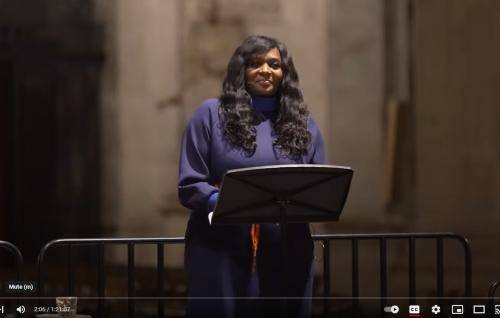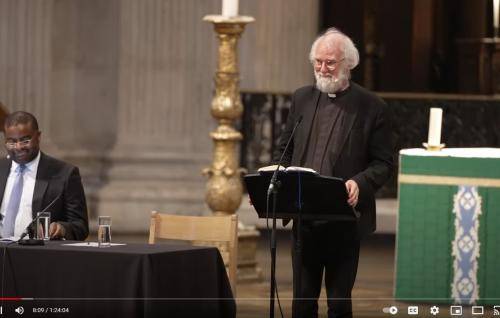Mary
Mary
Cally Hammond reflects on Mary, Mother of Christ, for the month of May.
1. Imagining Mary
May is Mary’s month, a valuable opportunity to spend time in the company of our Lord’s mother. Through no fault of her own, she has become a controversial character. Some Christian traditions revere her to excess. Others neglect and ignore her.
This disagreement goes back beyond the Reformation, into the fifth century, when Christians first began to discuss Mary as an agent – with a will of her own – in the great drama of salvation. The dedications of so many churches are a silent witness to belief that her role mattered. Her person was holy. Her patronage was powerful. But in the Church of England, Mary can still be a divisive character.
In the seventeenth century an Anglican priest called Jeremy Taylor believed that the Church of England needed a broader, more imaginative approach to faith, rather than a suspicious attitude towards any kind of religious enthusiasm. He wrote a book called The Great Exemplar (1657) which became a runaway success. Its full title reveals his new imaginative method, and his two-pronged approach: The Great Exemplar of Sanctity and Holy Life Described in the History of the Life and Death of the ever-Blessed Jesus Christ the Saviour of the World.
Taylor understood Jesus as an example of “sanctity”: of his very nature and essence pure and holy. But he also saw him as an example of “holy life”, teaching by example, inspiring us to imitate him. All through May Jeremy Taylor will be a guide on our journey. He will help us to understand Jesus’ mother, and see how she can illuminate our faith. When Mary learns that she is to be mother and maiden, in that moment, “two glories, like the two luminaries of heaven, meet in her”, says Taylor. It’s time to let her help us to find the divinity in our humanity.
2. Mary's Essence
Some are born great, some achieve greatness, and some have greatness thrust upon ‘em.
In Shakespeare’s time, Malvolio’s observation in his play Twelfth Night looked more like madness than ambition. Lady Catherine de Burgh would agree. In Jane Austen’s Pride and Prejudice she told Elizabeth Bennett, If you were sensible of your own good, you would not wish to quit the sphere in which you have been brought up.
Lady Catherine saw nothing positive in overturning the status quo. Malvolio was ridiculous for being a servant wanting to become a gentleman. But for all his pomposity, he did spot that greatness can be static (“born great”), active (“achieve greatness”), or passive (“thrust upon ‘em”).
Today, though some hierarchies persist, and others are even enshrined in law, poverty of ambition – the idea that there is no point in striving for achievement – is recognised as a social evil.
In the seventeenth century, Jeremy Taylor cut across popular notions of fixed hierarchies of “greatness” by taking Mary as his example. He looked at what her greatness consisted in. She was not remarkable for lineage or wealth. She had no deep knowledge of the world. But if her adult self can teach us about how the child became the woman, she must have arrived to her perfections, says Taylor, by a quiet and silent piety, the internal actions of love, devotion, and contemplation. He contrasts St. Paul, who travelled, preached, disputed, and suffered, to obtain his crown.
Mary shows us that our relationship with God, our holiness of life, is not the fruit of expertise or education, and certainly not ancestry or money. Yes, Taylor looks with seventeenth-century eyes on the ideal of womanhood (how could he not?). But he sees her strength and goodness quite as clearly as we can today.
She is not great because she is inexperienced, silent, and constrained within a narrow sphere. She is great because she did not even need to taste the fruit of vaulting ambition and find it dry and bitter. Her true greatness was not a virtue learned or striven for, but her essence, from the beginning.
3. The Annunciation
Jeremy Taylor’s devotion to the Blessed Virgin must have been shaped by his life, in which domestic felicities and tragedies formed his spiritual as well as emotional core. He felt those blessings strongly, but he also felt a call to communicate more widely the fruits of his reflections on the faith, by service in the ordained ministry.
We should be glad that he did, for his writings are wholesome and full of lovingkindness. For a while, he was a Fellow of Gonville and Caius College in Cambridge, and this may have helped to form his devotion to Mary, for the Annunciation is the College’s original dedication.
For Taylor, the Annunciation is two contrasting things at once: first the setting where the incarnation is disclosed and activated, and second, a homely scene, from which he draws reflections on Christ’s humility, as well as Mary’s:
Many times God is present in the still voice and private retirements of a quiet religion, and the constant spiritualities of an ordinary life.
Taylor uses his characteristic method – imaginative meditation – on St. Luke’s sparing words, to take the daring step of describing the moment of the incarnation. He does so in both prose and verse. Prose was his natural medium, and he pictures for us the moment as it happened:
without any obstreperous noises or violences to nature, but only the extraordinariness of an exaltation...and tranquillity fitted for the entertainment of the spirit of love.
Poetry did not come quite so easily to him as prose, but he attempts it in a way which links incarnation with creation, getting to the heart of the great miracle:
Eternity took the measure of a span,
And said,
Let us make ourself like man,
And not from man the woman take,
But from the woman, man.
4. Romantic and Classical Christianity
This present generation of Christians sits light to doctrine. Perhaps we have lost confidence that the old statements about faith make sense. Perhaps making faith accessible takes priority over making it comprehensible.
Two temperaments here conflict, the romantic and the classical. The classical temperament observes the rules of human society, seeking contentment through submission to those rules. Jane Austen’s heroines inhabit this world: society is what it is, and morality and faith are sometimes counter, but mostly concurrent, with it.
By contrast, the romantic temperament is a drive for self-expression, self-exploration, which kicks against society’s pricks and finds fulfilment sometimes in transgression, letting emotion triumph over self-restraint. Charlotte Brontë’s great heroine, Jane Eyre, exemplifies this. She recognises social constraints, and is conditioned by them, but not confined.
The first Christians fought and died, as much as they wrote and argued, to establish right-thinking formulations of Christian belief as rules. The Nicene Creed is one of many such formulations laid down as the deposit of faith took intellectual form.
Ours is an era of romantic Christianity. Feelings, emotions, intuitions prevail against outdated modes like duty, obedience, and ecclesiastical authority. At the centre of most people’s concern is not God, but themselves. Doctrine challenges this temperament, for, losing sight of it, we risk losing the Christian understanding of what, as well as who, we are.
There is still a virtue in faith unconfined by rules. For all the works of doctrine that have been written about Mary, the core of her appeal to Christians is simply that she represents them as they are: people who honour God, who want to learn him better, whose existence seeks not grand achievements but the “royalty of an inward happiness”, as Taylor reminds us:
Mary was engaged in the exercise of an ordinary and small economy and government, or ministries of a family.
Christ shared our humanity; Mary shares our human love for Jesus, her son, our brother.
5. Mary and the Christian calling
Sometimes the first Christian theologians wonder why God chose to effect salvation in the way he did. He could have saved us, one of them points out, by a simple divine fiat, “let it be so”. True, the omnipotent Father could have chosen any way he wished for the effecting of our redemption. But the means he did choose, says Jeremy Taylor, was to cure like with like:
The cure is best wrought by those instruments which...are the nearest to our constitution.
We have already found that the Annunciation had a special place in Taylor’s spirituality, through his imaginative approach to the how and why of its unfolding; and that the Blessed Virgin was an example to us not just of obvious virtues like piety and chastity, but also of less exalted ones, like contentment and devotion.
One prayer marks the pinnacle of Taylor’s imaginative meditation. In it he draws a parallel between the unique Mother of the Lord, and the universal calling of a Christian. In both, there is an incarnation: one in Mary’s womb, the other in the Christian’s soul. Both are effected by God’s creative Spirit.
In place of a womb he sets a heart, for the incarnation embraces male and female alike. In that heart Jesus is conceived; in the mind (the place of reason) he comes to birth, and so the Christian comes to maturity as a mother, fostering and nurturing the indwelling Lord as Mary did her Son, our Lord:
O holy and ever-blessed Spirit,
who didst overshadow the holy Virgin-mother of our Lord,
and caused her to conceive by a miraculous and mysterious manner,
be pleased to overshadow my soul, and enlighten my spirit,
that I may conceive the holy Jesus in my heart,
and may bear him in my mind,
and may grow up to the fulness of the stature of Christ,
to be a perfect man in Christ Jesus. Amen.








